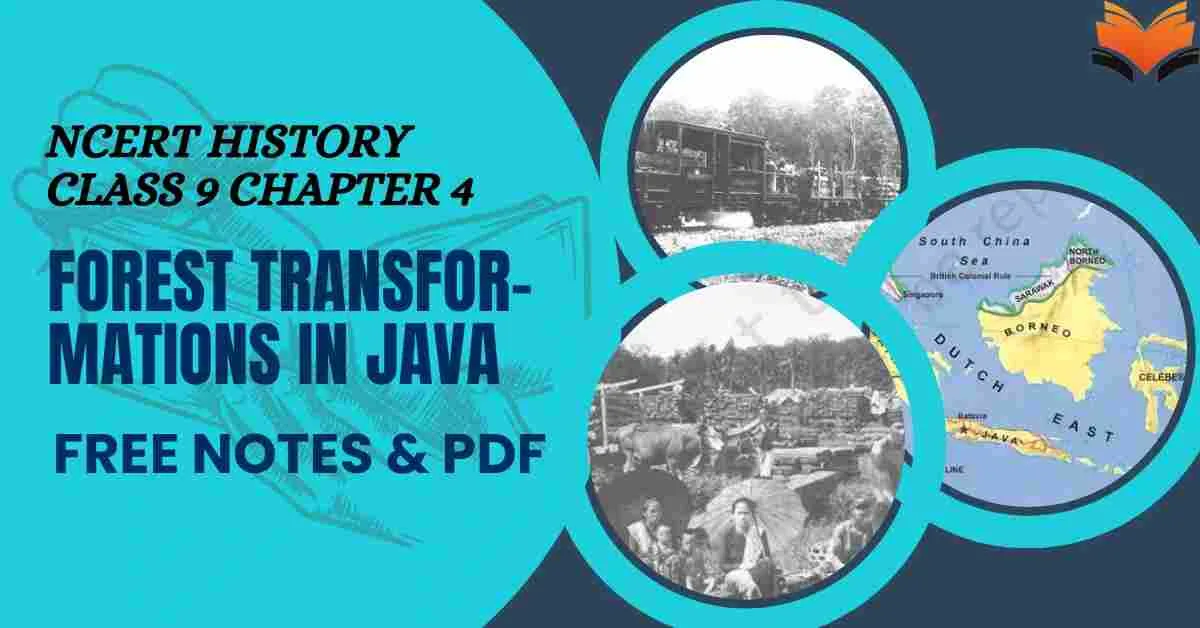Forest Transformations in Java – Concept & Notes PDF
Topic & sub-topics covered: Forest Transformations in Java and MCQs Questions: Forest Society and Colonialism (All single detail notes are exam-oriented).
We have discussed in-depth and exam-oriented pointers that can be asked in the board exam of class 9th about the “Forest Transformations in Java” from the NCERT History notes for class 9th chapter 4th “Forest Society and Colonialism“.
Download the NCERT History for Class 9th Chapter 4 Forest Society and Colonialism Notes PDF
NCERT History for Class 9th Chapter 4_ Forest Society and Colonialism Notes & MCQ’s Question-Answer
Preparing for Class 9 History? Chapter 4 Forest Society and Colonialism is an important topic that explains how colonial rule transformed forests, the lives of people who depended on them, and the environment itself. To make your preparation easier, we’ve created well-structured notes that highlight key events, important terms, and exam-oriented points in a simple way. With these notes, you can revise quickly and understand concepts like Deforestation, shifting cultivation, colonial policies, and resistance by forest communities. Download the NCERT History Class 9 Chapter 4 Forest Society and Colonialism Notes PDF and get everything you need for clear, focused exam preparation in one place.
Forest Transformations in Java
- Present status: Java is now famous as a rice-producing island of Indonesia.
- Past condition: Once, Java was mostly covered with forests.
- Colonial power: Indonesia was under the Dutch colonial rule.
- Forest laws: The Dutch introduced forest control laws, similar to those in British India.
- Beginning of forest management: Java was the place where the Dutch started forest management.
- Reason for forest exploitation: Like the British, the Dutch wanted timber from Java to build ships.
- Population in 1600: Estimated population of Java was 3.4 million.
- Settlements:
a. Many villages in fertile plains.
b. Also, many communities in mountains practising shifting cultivation.
The Woodcutters of Java
- Community: The Kalangs of Java were a skilled community of forest cutters and shifting cultivators.
- Importance of Kalangs:
a. They were so valuable that in 1755, when the Mataram kingdom of Java split, about 6,000 Kalang families were equally divided between the two kingdoms.
b. Their expertise was crucial for harvesting teak and for building palaces of kings. - Dutch control: In the 18th century, the Dutch gained control over the forests and tried to force the Kalangs to work under them.
- Resistance of Kalangs:
a. In 1770, the Kalangs rebelled by attacking a Dutch fort at Joana.
b. The uprising was eventually suppressed by the Dutch. - Kalangs = skilled forest cutters & shifting cultivators (core identity).
Dutch Scientific Forestry
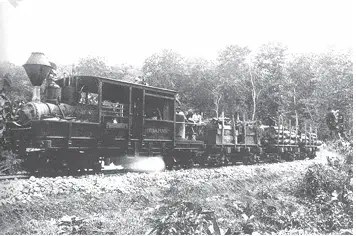
1. Dutch Forest Laws in Java:
- In the 19th century, the Dutch enacted forest laws in Java to control territory and forests, not just people.
- Villagers’ access to forests was restricted.
- Wood could be cut only for specific purposes (e.g., making river boats, constructing houses).
- Cutting was allowed only from selected forests under strict supervision.
- Villagers were punished for:
a. Grazing cattle in young forest stands.
b. Transporting wood without a permit.
c. Travelling on forest roads with horse carts or cattle.
2. Shipbuilding and Railways Demand:
- Similar to India, shipbuilding and railways increased the need for forest management.
- A forest service was introduced in Java.
- By 1882, 280,000 sleepers were exported from Java alone.
3. Labour Requirement & Exploitation:
- Large-scale forestry required labour for:
a. Cutting trees.
b. Transporting logs.
c. Preparing sleepers.
4. Blandongdiensten System
- The Dutch first imposed rents on cultivated forest land.
- Some villages were exempted from rent if they provided:
a. Free labour.
b. Buffaloes for cutting and transporting timber. - This system was called Blandongdiensten.
- Later, instead of rent exemption:
a. Villagers were given small wages.
b. But their right to cultivate forest land was restricted.
5. Key Exam Hints:
- Dutch forest laws = stricter than India’s (territory + people control).
- Punishments = for grazing, wood transport, road usage without permission.
- 1882 fact = 280,000 sleepers exported.
- Blandongdiensten system = free labour + buffaloes in return for rent exemption → later replaced by small wages, but cultivation rights restricted.
Samin’s Challenge
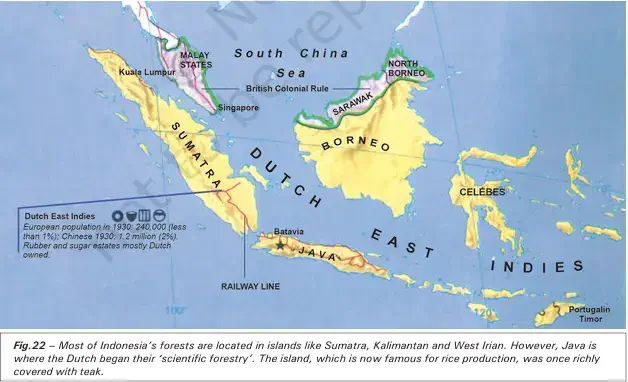
1. Origin of the Challenge:
- Around 1890, Surontiko Samin of Randublatung village (a teak forest village in Java) questioned state ownership of forests.
- His argument: The state had not created wind, water, earth, or wood, so it could not claim ownership of them.
2. Spread of the Movement:
- The challenge turned into a widespread movement.
- Samin’s sons-in-law helped in organising the movement.
- By 1907, nearly 3,000 families were following Samin’s ideas.
3. Forms of Protest:
- Non-violent resistance methods were used by Saminists:
a. Lying down on their land when Dutch came to survey it.
b. Refusing to pay taxes or fines.
c. Refusing to perform compulsory labour.
4. Key Exam Hints:
- Year to remember → 1890 (Samin’s questioning), 1907 (3,000 families joined).
- Village → Randublatung (teak forest village).
- Protest nature → non-violent & Gandhian-like methods (lying on land, refusing taxes/labour).
- Leadership → Surontiko Samin + supported by sons-in-law.
War and Deforestation
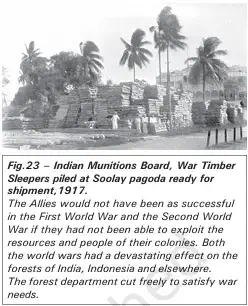
1. Impact of World Wars on Forests:
- Both the First World War (1914–1918) and the Second World War (1939–1945) had a major impact on forests.
- In India, forest working plans were abandoned, and the forest department cut trees freely to meet British war needs.
2. Dutch and Japanese Actions in Java:
- Just before the Japanese occupation of Java, the Dutch adopted a ‘scorched earth policy’:
a. Destroyed sawmills.
b. Burnt huge piles of giant teak logs to prevent Japanese access. - After occupation, the Japanese exploited forests recklessly for their war industries.
- They also forced forest villagers to cut down trees.
3. Villagers’ Role During the War:
- Many villagers took the opportunity to expand cultivation in forest areas when control was weak.
4. Post-War Challenges:
- After the war, it became difficult for the Indonesian forest service to regain this cultivated land.
- Similar to India, the conflict grew between:
a. People’s need for agricultural land.
b. Forest department’s desire to control and exclude people.
5. Key Exam Hints:
- India → unrestricted tree felling for British war needs.
- Java (Dutch) → scorched earth policy: destroyed sawmills & burnt teak.
- Japanese → reckless exploitation + forced villagers’ labour.
- Villagers → expanded cultivation during wartime.
- Post-war → conflict over land between people & forest department.
New Developments in Forestry
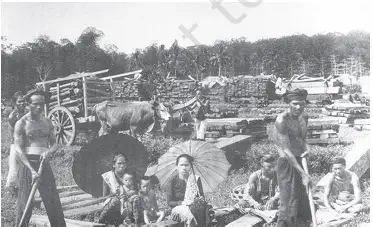
1. Shift in Forestry Policies (Since 1980s):
- Governments across Asia and Africa realised that scientific forestry and keeping forest communities away caused many conflicts.
- Focus shifted from timber collection → to forest conservation.
2. Role of Local Communities:
- Governments recognised that forest dwellers must be involved in conservation.
- India’s examples: From Mizoram to Kerala, dense forests survived because villages protected them.
- Forests preserved in sacred groves:
a. Sarnas
b. Devarakudu
c. Kan
d. Rai
3. Community Forest Protection Practices:
- Some villages patrol forests themselves, instead of depending on forest guards.
- Households take turns to protect the forests.
4. Emerging New Approaches:
- Local communities + environmentalists are now working on different forms of forest management.
5. Key Exam Hints:
- 1980s → shift from timber extraction to conservation.
- Villagers’ role: protecting forests through sacred groves & patrolling.
- Involvement of people + environmentalists → new models of management.
Source G
- Speaker: Dirk van Hogendorp, an official of the United East India Company in colonial Java.
- Audience: Addressed to the people of Batavia (modern Jakarta).
1. Concerns Highlighted:
- Dutch fleets destroyed, trade declining, and navigation collapsing.
- Dutch were forced to purchase timber and ship-building materials from northern powers at high costs.
2. Importance of Java’s Forests:
- Claimed Java’s forests had enough timber to build:
a. A strong navy
b. Numerous merchant ships - Stated that forests of Java could be inexhaustible if managed properly.
3. Underlying Message:
- Urged for better forest management and care.
- Suggested that forests were a valuable natural resource for Dutch economic and military power.
Next & Previous Topics of NCERT/CBSE History Class 9 Chapter 4: Forest Society and Colonialism
| Topics No. | Topics Name |
|---|---|
| 1 | Why Deforestation? |
| 2 | The Rise of Commercial Forestry |
| 3 | Rebellion in the Forest |
| 4 | Forest Transformations in Java |
MCQs on NCERT History Class 9 Chapter 4 Topic – Forest Transformations in Java
Here are the top exam-oriented MCQ-type questions on “Forest Transformations in Java” that you should prepare for your CBSE or state board exams:
Question 1. Java is now famous as:
a) Tea-producing island
b) Cotton-producing island
c) Rice-producing island
d) Coffee-producing island
Answer: c) Rice-producing island
Question 2. Which European colonial power controlled Indonesia?
a) Portuguese
b) Dutch
c) French
d) British
Answer: b) Dutch
Question 3. Why did the Dutch want timber from Java?
a) For building houses
b) For building ships
c) For making furniture
d) For export to India
Answer: b) For building ships
Question 4. In 1600, the estimated population of Java was:
a) 1.4 million
b) 2.4 million
c) 3.4 million
d) 4.4 million
Answer: c) 3.4 million
Question 5. Which community of Java were skilled forest cutters and shifting cultivators?
a) Muria Gonds
b) Kalangs
c) Halbas
d) Dhurwas
Answer: b) Kalangs
Question 6. In which year was the Mataram kingdom of Java split?
a) 1700
b) 1725
c) 1755
d) 1770
Answer: c) 1755
Question 7. How many Kalang families were divided between the two kingdoms of Java?
a) 2,000
b) 4,000
c) 6,000
d) 8,000
Answer: c) 6,000
Question 8. In 1770, the Kalangs resisted Dutch control by attacking which fort?
a) Batavia
b) Joana
c) Surabaya
d) Yogyakarta
Answer: b) Joana
Question 9. In the 19th century, the Dutch introduced forest laws in Java mainly to:
a) Control timber extraction
b) Promote shifting cultivation
c) Expand rice production
d) Encourage trade with India
Answer: a) Control timber extraction
Question 10. Under Dutch forest laws, wood could only be cut for:
a) Export purposes
b) Ship-building and railway
c) River boats and house construction
d) Sacred groves
Answer: c) River boats and house construction
Question 11. Villagers in Java were punished for:
a) Cutting bamboo
b) Travelling with horse carts on forest roads
c) Using forests for hunting
d) Selling rice in the market
Answer: b) Travelling with horse carts on forest roads
Question 12. In which year were 280,000 sleepers exported from Java?
a) 1860
b) 1870
c) 1882
d) 1890
Answer: c) 1882
Question 13. What was the Dutch system of forced free labour by forest villagers called?
a) Ryotwari
b) Zamindari
c) Blandongdiensten system
d) Permanent Settlement
Answer: c) Blandongdiensten system
Question 14. Under the blandongdiensten system, villagers were:
a) Exempted from rent if they provided labour
b) Given large land grants
c) Allowed to freely graze cattle
d) Permitted to sell timber in markets
Answer: a) Exempted from rent if they provided labour
Question 15. Who started questioning Dutch state ownership of forests around 1890?
a) Gunda Dhur
b) Surontiko Samin
c) Bhondia Majhi
d) Alluri Sitarama Raju
Answer: b) Surontiko Samin
Question 16. Surontiko Samin belonged to which village?
a) Bastar
b) Randublatung
c) Batavia
d) Mizoram
Answer: b) Randublatung
Question 17. By 1907, how many families were following Samin’s ideas?
a) 1,000
b) 2,000
c) 3,000
d) 4,000
Answer: c) 3,000
Question 18. Which of the following was NOT a method of protest used by the Saminists?
a) Lying down on land during surveys
b) Refusing to pay taxes
c) Burning police stations
d) Refusing to perform labour
Answer: c) Burning police stations
Question 19. During WWI and WWII, forest trees were cut freely mainly for:
a) Local consumption
b) British war needs
c) Expansion of cultivation
d) Selling to China
Answer: b) British war needs
Question 20. What was the ‘scorched earth policy’ followed by the Dutch in Java?
a) Burning of villages
b) Burning sawmills and teak logs to stop Japanese use
c) Destroying farmlands
d) Flooding forests deliberately
Answer: b) Burning sawmills and teak logs to stop Japanese use
Question 21. Which country occupied Java during WWII?
a) Britain
b) France
c) Japan
d) Portugal
Answer: c) Japan
Question 22. After WWII, what conflict arose in Java similar to India?
a) Farmers vs. merchants
b) People’s need for agricultural land vs. forest department’s control
c) British vs. Dutch
d) Traders vs. soldiers
Answer: b) People’s need for agricultural land vs. forest department’s control
Question 23. Since which decade did governments across Asia and Africa begin to shift focus to conservation?
a) 1950s
b) 1960s
c) 1970s
d) 1980s
Answer: d) 1980s
Question 24. In India, dense forests have survived mainly because of:
a) Scientific forestry
b) Sacred groves protected by villages
c) British forest laws
d) Government plantations
Answer: b) Sacred groves protected by villages
Question 25. What were sacred groves called in different parts of India?
a) Vana and Upvanas
b) Sarnas, devarakudu, kan, rai
c) Pahadi and Jangal
d) Bhoomi and Jalvan
Answer: b) Sarnas, devarakudu, kan, rai
Question 26. Who wrote about the richness of Java’s forests in colonial times?
a) William Ward
b) Dirk van Hogendorp
c) Susobhan Sarkar
d) James Mill
Answer: b) Dirk van Hogendorp
Question 27. According to Dirk van Hogendorp, Java’s forests could:
a) Feed the entire population
b) Build a navy and merchant ships
c) End famine in Asia
d) Supply cotton for Europe
Answer: b) Build a navy and merchant ships
Question 28. What belief did Dirk van Hogendorp express about Java’s forests?
a) They were finite and weak
b) They would vanish soon
c) They were inexhaustible under good care and management
d) They could only supply timber for 50 years
Answer: c) They were inexhaustible under good care and management

